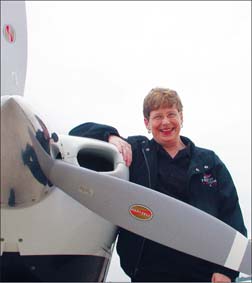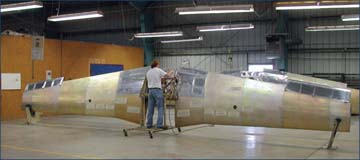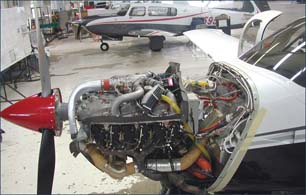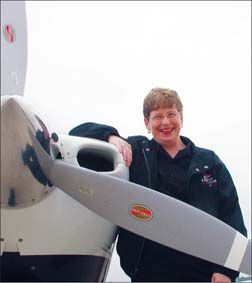
by Paul Bertorelli
In our darkest nightmares of nuclear Armageddon, we can imagine only a few living things surviving among the cinders, maybe a few billion mutant cockroaches, some hardy desert reptiles and a couple of guys hammering Mooneys together in Kerrville, Texas.
Many an airplane company has folded, revived and folded again, but Mooney has been driven to near extinction and brought back from the dead more times than most of the people who work there can even remember. (Al Mooney himself navigated through at least one bankruptcy and resurrection.)
Most recently, the company emerged yet again from bankruptcy in 2004 and has restructured its finances, rebuilt the workforce-a necessarily skilled one-and trimmed down the model line to only two offerings.
That Mooney has managed this high-wire survival act so many times is less a testament to the often toxically optimistic myopia of people who involve themselves in selling airplanes than it is a validation of what we see as an undeniable truth: Al and Art Mooneys notion that an airplane can-and should-be an economical compromise of speed, comfort, economy and cost is as sound now as it was in 1953 when the M-20 line first came to life.
No amount of boneheaded mismanagement, harsh market conditions or fierce competition will change that. You have only to sit in a new, glass-panel Ovation2 GX to understand that the fundamental design is as modern and as good as any light aircraft made in the world today. True, its build cost may be higher by dint of having more parts and pieces, but the end result competes equally with the likes of new-age offerings from Cirrus, Columbia and Diamond.
The trick is not building a good airplane, but making money at building a good airplane. The latest entity to take on this daunting challenge at Mooney morphed from a company originally launched to develop the now abandoned JetCruzer twin turboprop, Advanced Aeronautical Structures, Inc. When that project went defunct, AASI purchased the assets of the then-bankrupt Mooney Airplane Company and formed the Mooney Aerospace Group, Ltd., a publicly owned entity whose sole operating assets are currently the Kerville-based Mooney Airplane Company.
In late 2004, a federal bankruptcy court approved Mooney Aerospaces reorganization plan and by early 2005, the company was again ready for a fresh start. To oversee the reemergence, Mooney hired a new CEO: Gretchen Jahn, who arrived in Kerrville with the assignment to once again help the company re-invent itself, clean out the dead wood and revive the product line and service operation.
Jahn, who has been a pilot for 20 years-although not a Mooney owner-came to Kerrville with a background in tech entrepreneurship, development and management. Given Mooneys checkered fiscal history, a potential buyer of a half-million dollar Ovation2 or the new Acclaim might fairly ask how the company plans to sustain itself and avoid yet another bankruptcy. During a recent visit to Kerrville, we asked Jahn this very question. Heres our report.
———-
What is the current financial status of the company? Is the wolf being kept sufficiently far away from the door?
We just filed our 10K with the Securities and Exchange Commission and it shows that we continued to have losses last year. A major reason for that is that we as a board and as a company made a decision that we would invest last year, ramping up the production and investing in sales and marketing to deliver airplanes. This year will require less investment to achieve that. Youll see this in our quarterly reports. I cant go into the details, because were a publicly traded company.
Right now, we have no concerns relative to cash and cash flow. As we rebuild the company, we have very significant support from investors and shareholders.
If sales are up, which they are, and expenses will be less this year, when will Mooney turn the corner?
I cant speculate on that. What I can say that is if you look at our production rate, we went from 36 deliveries in 2004 to 85 in 2005. And we have been talking very publicly about our focus on predictability and improving the quality of our products. The aircraft has very high quality when we deliver it to a customer. But its the process of getting there that doesnt have predictability. The kind of quality we would like to see the first time at every step along the way now requires too much rework and too much effort. So we need to get a much smoother flow to achieve all of this.
What is it about building metal airplanes that seems to drive so many companies to the brink of extinction so often?
Its the nature of manufacturing. Its not specific to Mooney and its not specific to airplanes. You need to have a smooth flow through the entire process, with no lumps and bumps.So you know if you put in X amount of effort in the beginning, youre going to get Y out in Z amount of time. There are so many moving parts within a manufacturing company and so many things that have to be coordinated, everything is constantly shifting based on demand, product mix and the state of the company and the health of your suppliers.
During the late 1960s, Mooney was rightfully considered a major leaguer, making 600 or 700 airplanes a year. It must have had an efficient manufacturing process then.

At that time, the company was flowing very well. The number of hours needed to build an airplane was we’ll under control. You could know when your delivery dates were going to be and it was all predictable. Mooney has forgotten how to do that.
How did that happen?
We have corporate Alzheimers. We do not have a staff of people who have been with Mooney a long time. We have, Id guess, about a third of the workforce who have been with the company for a while and the rest are new. The folks who have been here a long time have done the best they could with what they had. That wasnt necessarily efficient in the long run but it conserved cash in the short run. Were trying to change that.
Were going back department by department and looking at how we can do things more efficiently…and we hear people say, oh yeah, thats the way we used to do it. Plus, we have a high learning curve for new people. When I started here in October 2004, we had about 280 people. Now we have 400.
In touring the plant, we notice that Mooneys require more operations to build than say, a Cirrus or a Columbia. Can Mooney continue to compete in such an environment?
It most definitely can. We have good labor rates here in Texas and we don’t have a union. Second, we need to compare the investment costs necessary for making the large fiberglass parts that we don’t have in the Mooney. That doesnt mean we should rest on our laurels. But in terms of cost structure, we can be competitive.
The last time we visited Kerrville, the plant was struggling with making the build process more efficient. We see that this is still underway. Is the plant properly equipped?
It is sufficiently equipped. In fact, there are a number of places where we have excess capacity. We have more than sufficient space. Some of our machinery is old and has been neglected. So were in need of a preventive maintenance plan and its likely we’ll need to do some repair.
We have some capital improvements that we need to do, specifically repairing the roofs of several of our buildings, plus paving the parking lot. Thats being done through a long-term loan from the state of Texas.
What, specifically, are you doing to improve manufacturing efficiency?
Right now, were asking ourselves what are we best at doing. What are others best at doing? Weve also come to the conclusion that for some parts and some assemblies, it really would be better to have other folks make some of those for us. Were examining about everything we do here. For example, are we the best at building the landing gear or would those parts better be made elsewhere?
A key element in the new manufacturing effort is to be more predictable. We have seen significant improvement all around the plant but our Achilles heel continues to be paint. The facility is old, its in need of work and were reluctant to invest in it because its really not optimal. Were looking at a host of opportunities to address that.
Id use Continental and S-TEC as examples, because weve visited both. Theyve been down the lean manufacturing road so they know how to decrease the amount of time that it takes to get a product out the door. S-TEC has been able to significantly improve its sales and profitability with less space and fewer people. Continental, who we see as a terrific partner, has done the same. Its going to take us several years to get there.
The General Aviation Manufacturers Association recently reported a record quarter in GA sales. Will you return to much larger production numbers? Doesnt rapid expansion carry risk?
We see ourselves as a niche product, not a high-volume product. Thats why its so important to us to understand our customers, both current and prospective, a good portion of whom are current Mooney owners.
And yes, expanding rapidly is risky. We went down that path last year and we had good reasons for doing that. We needed to get to a specific size and presence in the market to be able to demonstrate that we could produce the airplanes were producing today. But no, we are not a high-volume company. we’ll leave that to other companies.
Mooney sold 85 airplanes in 2005. Whats the ideal balance for sustainable profit?
I wish I could provide you with the numbers, but I cant. If you look at our current SEC 10K, you would be disappointed. But we believe we see the path forward and were on that path. Certainly, we felt comfortable enough to make the considerable financial investment in a new model. There’s no way we would have done that if there were any concerns about the financial health of the company.
We just returned from looking at the Acclaim over in the test hangar. How did this design come about?
We did a significant amount of market research and what our customers told us is that they wanted more speed. And the result of that is the Acclaim, which has replaced the Bravo. Were still refining the airplane in flight testing. I think there’s still more speed that we can get out of it. I was really pleased with seeing 236 knots going to Sun n Fun.
With the demise of the Bravo, the line is now down to only two models. Is that sufficient?
My feeling is that long term, we will need additional products. But first, we need to know what our customers want. In terms of what we do next, we need additional clarity. Were doing some research on market segmentation before we choose the next step. People ask me if its going to be a turboprop. Is it going to be a jet? It could be any of those.
Cirrus has obviously done we’ll by selling airplanes with ballistic parachutes. Have you considered that for the Mooney line?
We have thought about it. We don’t have a huge amount of demand for the parachute from our customers. Were looking at it as an option. But we havent made any decisions. With our roll cage, we certainly have some very obvious attach points. From a technical point of view, its a relatively easy engineering effort.
If Mooneys did have the BRS, would that move into the broader market Cirrus now occupies?
My belief is that our target market is owners who are looking to step up, say from a Cirrus. I don’t see us having direct competition with Cirrus, although we do have some overlap.

In fact, Im glad that Cirrus came along, theyve revitalized the market. Theyre getting people into aviation who otherwise wouldnt consider it. Theyre expanding the market for all of us. I see our greatest competition as the Columbia and piston twins.
Speaking of Columbia, it has experimented with Continentals PowerLink FADEC, but it doesnt offer this system in a production aircraft. Why didnt Mooney use this on the Acclaim?
We did consider it. But at the time we made the choice, Mooney was still suffering under the repercussions of the Porsche engine, which was one of the earliest FADEC engines. With that negative mark on our reputation, we felt the timing wasnt right for us to introduce a FADEC model. As it becomes more we’ll known and we’ll accepted, FADEC represents a natural evolutionary step for us.
But the Porsche Mooney is ancient history. That was in 1988…
Yes, but some of the owners are still out there. Theyre vocal and theyre concerned now that the engine is getting to the end of its useful life. They cant get parts because of product liability concerns.
As we go to press this month, there’s rising concern that fuel prices will kill any potential growth in GA. Whats Mooneys response to that?
On the one hand, its a concern. It may factor in peoples buying decisions. I see that impacting the fleet of older airplanes. That could impact our service business, which is a profitable part of the company. But if you look at new aircraft, high fuel prices make the Mooney look that much more attractive because were so much more fuel efficient.
Also With This Article
“Acclaim: Speed With Economy”





